
- Home
- India
- World
- Premium
- THE FEDERAL SPECIAL
- Analysis
- States
- Perspective
- Videos
- Sports
- Education
- Entertainment
- Elections
- Features
- Health
- Business
- Series
- In memoriam: Sheikh Mujibur Rahman
- Bishnoi's Men
- NEET TANGLE
- Economy Series
- Earth Day
- Kashmir’s Frozen Turbulence
- India@75
- The legend of Ramjanmabhoomi
- Liberalisation@30
- How to tame a dragon
- Celebrating biodiversity
- Farm Matters
- 50 days of solitude
- Bringing Migrants Home
- Budget 2020
- Jharkhand Votes
- The Federal Investigates
- The Federal Impact
- Vanishing Sand
- Gandhi @ 150
- Andhra Today
- Field report
- Operation Gulmarg
- Pandemic @1 Mn in India
- The Federal Year-End
- The Zero Year
- Science
- Brand studio
- Newsletter
- Elections 2024
- Events
- Home
- IndiaIndia
- World
- Analysis
- StatesStates
- PerspectivePerspective
- VideosVideos
- Sports
- Education
- Entertainment
- ElectionsElections
- Features
- Health
- BusinessBusiness
- Premium
- Loading...
Premium - Events
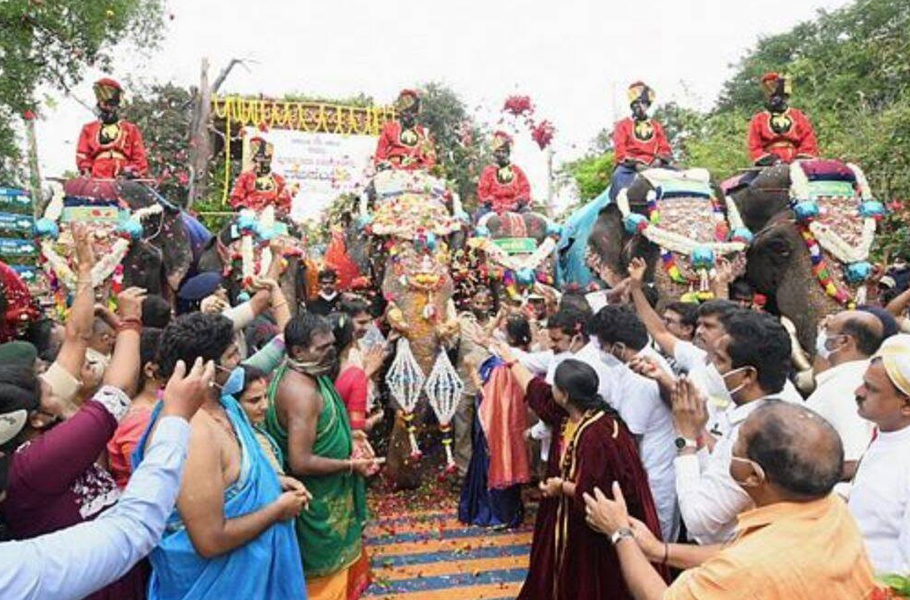
Jumboo Savari: Why the legend of this Abhimanyu will never get old

The Pandavas had already served 12 years in exile, away from their palace and princely lives. But it was the 13th year, which they were worried about the most because it had to be served incognito. The punishment for being discovered was a repeat of the exile term. They could change the guise but what were they to do with their weapons. Legend has it that the Pandavas decided to hide them...
The Pandavas had already served 12 years in exile, away from their palace and princely lives. But it was the 13th year, which they were worried about the most because it had to be served incognito. The punishment for being discovered was a repeat of the exile term. They could change the guise but what were they to do with their weapons.
Legend has it that the Pandavas decided to hide them all behind a banni tree in Mysuru. For over 200 years, decked up in ceremonial finery, 12 caparisoned elephants have been marching elegantly from the Amba Vilas Palace to that legendary hideout, Bannimantap. Incidentally, all elephants get their names from characters in Mahabharta.
This nearly five-km walk – now world famous as Jumboo Savari – interrupted by dance troupes and lakhs of enthusiastic watchers marks the culmination of the 10-day Dasara festivities on Vijayadashmi in Mysuru.
For the jumbos, who participate in the procession, the preparations begin much in advance with weight-training exercises. Only the strongest from the herd gets to carry the Golden Howdah with the idol of Chamundeshwari – the presiding deity of Mysuru city – on its back.

This year, much like 2020, the responsibility will be shouldered by Abhimanyu, a 59-year-old tusker. Abhimanyu hails from the lineage of elephants of great strength, including Drona, Balrama and Arjuna. With COVID-19 restrictions in place, however, Abhimanyu wouldn’t be able to walk through the five-km distance and only about 500 people will be able to watch the procession inside the Mysuru Amba Vilas Palace.
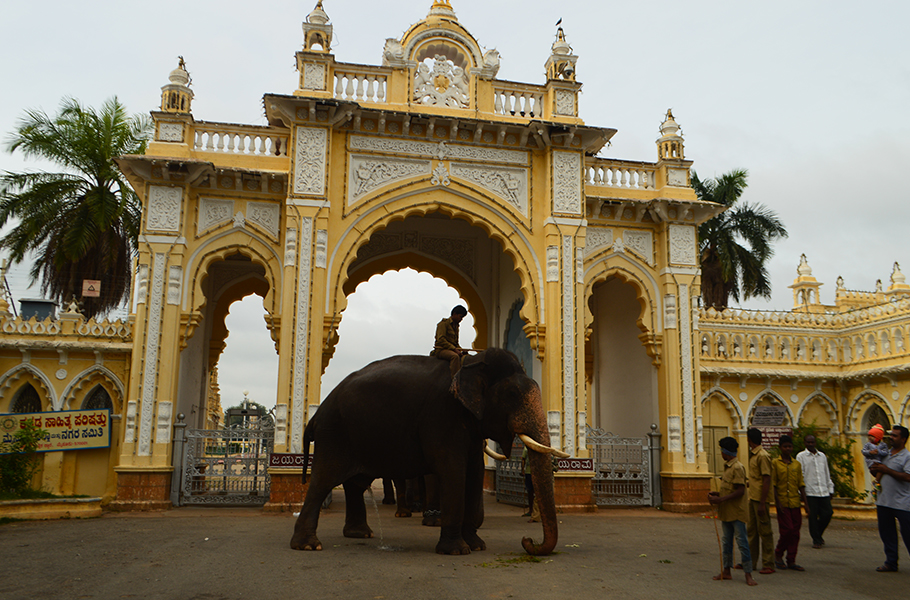
Preparations
Even for this shorter version of the procession, elephants go through a daily weight training routine, as a part of which heavy sandbags are mounted on their backs.
On the first day of training, rituals are performed at Kodi Rameshwara temple for all elephants. Through the training, the weight on their backs is gradually increased to ensure they perform the task perfectly. The training also helps to familiarise the Dasara elephants with the Jumboo Savari route.
Tusker Abhimanyu carried a 500 kg sand bag so that he could carry the golden howdah with ease on the final day.
Two other elephants are trained to carry the Golden Howdah to ensure there is a backup ready if the main elephant falls ill on the day of the procession.
Why Abhimanyu
Though Abhimanyu is going to be the lead tusker only for the second time this year, it has been part of the Jumboo Savari in one form or the other for the last 22 years. As part of the last assignment, Abhimanyu drew the Ane Gaadi, which is a trailer full of musicians of the royal court.
Fifty-nine-year-old Abhimanyu is strong, calm and well-behaved. More importantly, the tusker is daring and not afraid of any from his own ilk. A flatter and longish vertebral column makes him the ideal jumbo to carry the Golden Howdah.
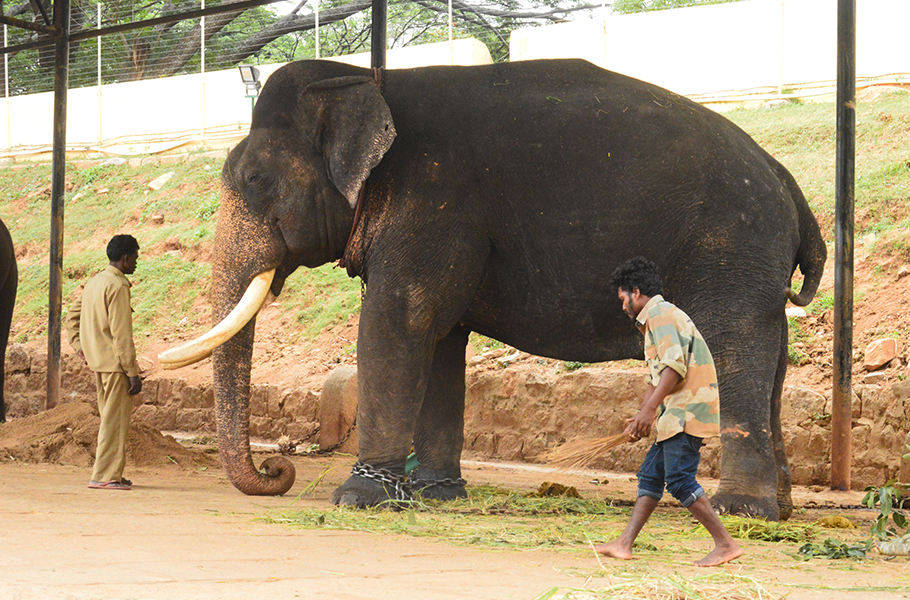
“The Golden Howdah sits on his back securely,” says deputy conservator of forests (wildlife), Mysuru Division, Dr V Karikalan.
Guts and glory
Deep in the jungles of Nagarholay, Abhimanyu is nicknamed ‘AK-47’ by the members of the Kavadi tribe. “From cornering the rogue wild elephants, to chasing them deep into the forests, to keeping them confronting humans and even taming the wild elephants, Abhimanyu does what he’s tasked to do. Since the tusker is always composed, it allows Abhimanyu to channelise its energy in whatever task it has to perform,” say the Kavadis who look after the tusker at the Mathigodu elephant camp in Nagaraholay National Park.
At 4,920 kg, Abhimanyu has the right body weight to be strong and powerful and also agile when needed. The animal has taken part in over 150 operations of elephant capture and training in Karnataka, Kerala, Maharashtra and Chhattisgarh. “Abhimanyu has become our elephant ambassador,” Dr Karikalan tells The Federal.
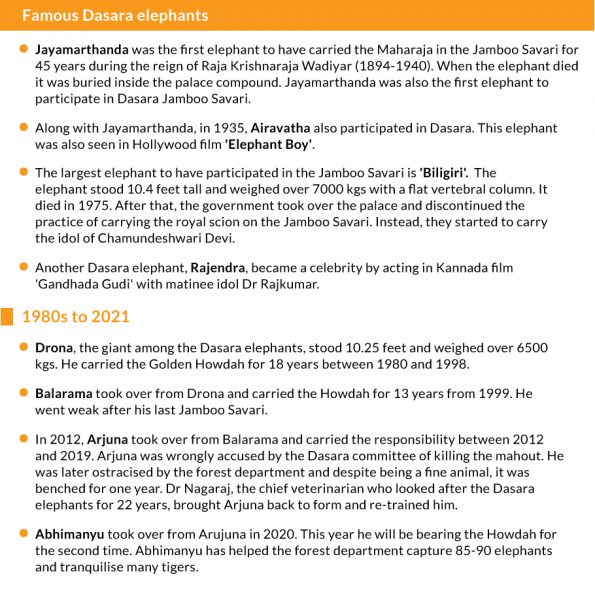
Captured in 1977 from Hebballa in Kodagu district, Abhimanyu has helped the forest department officials drive away not just other elephants but also tigers that have gotten too close to human habitation.
Elephant veterinary expert Ramesh V says he is yet to see an elephant getting stronger at the age of 59 like Abhimanyu.
An example of his strength was seen in 2013 when two elephants went on a rampage in Hassan city. Abhimanyu single-handedly pushed both into the waiting trucks.
In another operation, when its own Dasara teammate Gajendra went berserk in Biligiri Ranganatha Swamy Tiger Reserve, it was Abhimanyu who with the help of Harsha (another elephant) calmed down Gajendra.
Incidentally, Gajendra and Abhimanyu had once teamed up in one of India’s biggest operations to capture wild elephants. In 1990, a herd of 22 wild elephants had killed about 300 people in Chhattisgarh’s Sarajuga. Fear hung thick in the air across 90 villages for people didn’t know when another attack was coming their way. The Wildlife Division experts in the forest departments of Karnataka and Chhattisgarh zeroed in on Abhimanyu to lead a team of 32 elephants along with Gajendra, Bahaddur and Sri Rama. Abhimanyu and team did manage to help the forest department capture and translocate the 22 tuskers, says elephant veterinarian Dr Chittiappa, who worked closely with Abhimanyu’s team.
Abhimanyu’s heroics are well documented in the 2013 film Last Migration. The film went on to win the Green Oscars and Wildscreen Panda Award.
Abhimanyu and his mahout
Abhimanyu has been with two mahouts since he crossed over from the wild jungle life to a life alongside humans in 1977. Sanappa was Abhimanyu’s first mahout. This allowed Sanappa’s son JS Vasanth to be around Abhimanyu since childhood. When Sanappa retired from his duties, Vasanth emerged as the natural choice to be Abhimanyu’s mahout.
For years, Vasanth roamed around with Abhimanyu in the deep forests of Mathigodu but managed to get the opportunity to ride along with the Golden Howdah only in 2019. “However, Abhimanyu had drawn the Aane Gaadi for 10 years and all those years I had been the mahout,” said Vasanth.
The mahout believes Abhimanyu could be the reason he is alive today. Every step he took, every battle fought with rogue elephants or cornering a man-eater tiger, Abhimanyu took extreme care to keep himself and his mahout out of harm’s way. Vasanth says during many tiger capture operations from Gopalaswamy Betta forest range to Nagarahole Sunkadakatte, it was Abhimanyu who came to his rescue.
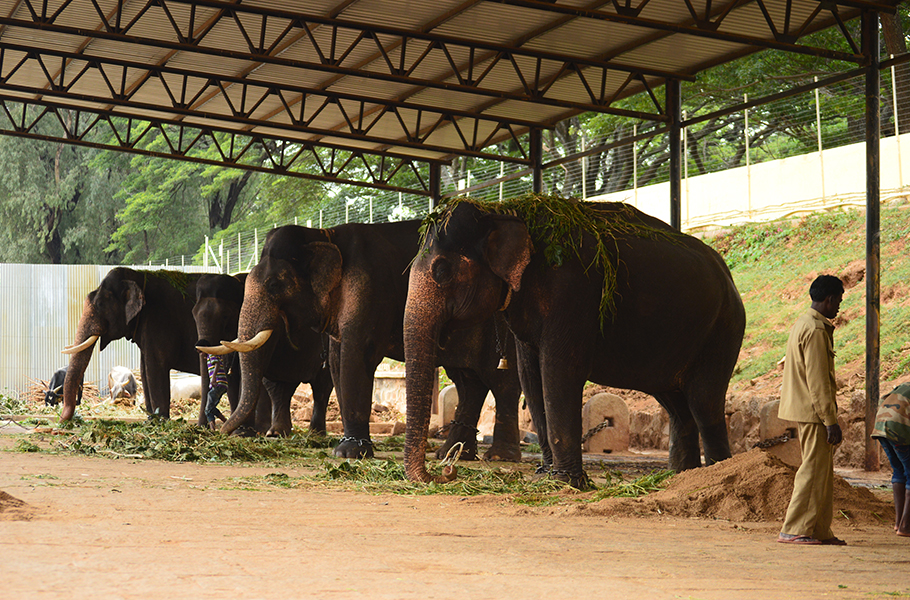
Thanks to Abhimanyu, Vasanth was the only mahouth from Karnataka who participated in the Asian Elephants Relationship-Building workshop in Indonesia. The elephant’s qualities, Vasanth says, left the participants of the workshop dazzled.
Even though Abhimanyu would get his second chance today to lead the Jumboo Savari, he is yet to get a chance at the full five-km glorious walk from the palace to Bannimantap. With his strength only growing, as vets point out, Abhimanyu may soon add the feat to his list of achievements.
